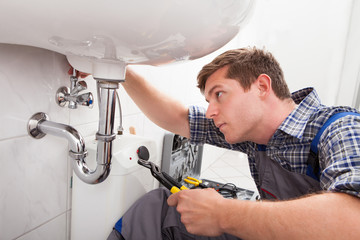Are you looking for a rewarding career that involves hands-on work and helping people? A career as Clearwater FL Plumber may be the perfect choice for you.

Plumbing is a complex trade that requires years of training and experience to master. It is also a physically demanding job involving working in cramped spaces and being on-call for emergencies.
Backflow preventers are crucial to ensuring the safety and quality of your water. They help keep dangerous contaminants from entering your home’s water supply, which can cause serious health problems. If your backflow prevention device isn’t properly installed or maintained, it could fail to protect your water. This is why it’s important to hire a plumber with experience installing and servicing backflow preventers.
You should also check with your city to see if you require a backflow preventer. It’s typically required for businesses and multi-family homes, but may not be necessary for single-family homes. If you do need one, make sure to hire a certified installer and schedule annual inspections.
There are different types of backflow preventers, depending on the size and type of water system they’re protecting. Two of the most common are dual check valve assemblies and pressure vacuum breaker assemblies. You can find these at most plumbing and hardware stores, but you’ll need to talk with your plumber to ensure they’re the right ones for your water system.
Most newer plumbing fixtures have built-in backflow prevention. For example, toilet fill valves and most faucets have an air gap that creates a seal between the bottom of the tank and the bottom of the spout, preventing backflow. Clothes washers, dishwashers, and refrigerator/ice makers also use this type of backflow protection.
A backflow preventer is usually installed at the water meter. It’s also recommended wherever potable and non-potable water lines connect. Backflow preventers help ensure the purity of your drinking and cleaning water, especially when there are pressure changes in the system.
The first step in backflow prevention is to get a permit from the local government. This process is usually overseen by a Licensed Master Plumber. Once the permit is granted, a professional engineer or registered architect must prepare a backflow plan for your property. This is then sent to the department for approval. Once approved, you can hire a Licensed Master Plumber to install the backflow prevention device.
It’s important that your backflow preventer is installed in a location where it can easily be serviced and accessed for testing and maintenance. This is especially true for installations in a vault below the finished grade or on a structure above the finished grade, since these are considered confined spaces. In these areas, you must follow special entry and exit protocols to avoid hazards such as a lack of oxygen or dangerous gases.
Drain Cleaning
Drains are a part of your home that you don’t think about on a regular basis — until they stop working. Clogged drains can be a real pain, but plumbers have a lot of tools at their disposal to get them back up and running in no time. One of the most important things you can do for your plumbing system is to schedule regular drain cleanings. This helps prevent serious clogs and promotes longevity for your pipes.
Liquid drain cleaners are a common and affordable option for clearing blocked drains. These cleaners work by creating a chemical reaction with the organic materials that cause a clog, such as hair and food particles. This reaction is exothermic, which means it produces heat, softening the clog and making it easier to remove.
For more stubborn blockages, a plumber might use a mechanical drain cleaner like a snake. These long coils of metal can grab and dislodge clogs, as well as clean the sides of the pipe walls without using caustic chemicals. If you’re looking for an eco-friendly alternative, try a biodegradable drain cleaner that breaks down proteins in the waste to clear away clogs safely and effectively.
Another option is to use a high-powered water hose called a hydro jetting machine, which blasts water into the pipes at a force that can dislodge even the most stubborn clogs and destroy them. This method is especially useful for removing grease buildup in kitchen sinks and drains.
A plumber may also recommend a periodic drain flushing service. This process involves flushing out your entire plumbing system with a high-pressure water hose, which can remove residue and prevent future clogs. Plumbers often use video inspection equipment to view the inside of your pipes, which can help them determine whether there are clogs or other problems. This technology allows them to quickly and accurately pinpoint issues, so they can repair them before they worsen. This can save you a lot of money in the long run by preventing costly repairs and replacements. This is why it’s so important to choose a plumber with the right qualifications and experience.
Water Heater Installation
Water heater installation is a project that can be completed by a plumber, but it requires a high level of skill and knowledge of local building codes. Plumbers should always read the manufacturer’s instructions for each model, and follow any additional requirements that the code specifies. This ensures a safe and proper operation of the appliance, as well as compliance with all applicable codes.
Prior to working on the water heater, a plumber should locate the hot and cold water supply valves and shut them off. This prevents water flow during the work, which can lead to property damage or serious injury. They should also turn off the power supply to the water heater by locating the circuit breaker and switching it off.
Once the water heater is disconnected from the power source, the plumber should drain it. They can do this by attaching a garden hose to the valve near the bottom of the tank and placing the other end over a floor drain or running it outdoors. The plumber should open the drain valve slowly to avoid spilling any hot water, and allow the tank to empty completely before turning off the valve and removing the hose.
If the hot and cold water lines are made from copper tubing, a plumber should replace them with new PEX tubing to improve water quality and prevent corrosion. PEX tubing has a plastic lining that limits bacteria from growing on the inside, and it has a higher boiling point than traditional copper tubes. Plumbers can install PEX tubing by cutting it to the required length, threading it onto galvanized nipples at the top of the water heater, and soldering on new fittings.
Plumbers should also install a temperature and pressure relief valve, which is designed to prevent overheating or overpressure in the hot water tank. If the temperature or pressure reaches a dangerous level, the relief valve discharges water through a pipe into a bucket to bring it down. They should also connect a ground wire from the incoming power line to the green ground screw on the water heater.
Water Filtration
Whether it’s installing a new water heater or replacing worn washers and gaskets, plumbers are responsible for the maintenance of water supply systems and appliances. They use their knowledge of building codes, water conservation practices and physics to ensure that plumbing systems work properly and safely.
Many states require plumbers to obtain a license before performing work. The licensing process can vary slightly depending on the state, but generally includes an exam and background check. Plumbers must also keep up to date on the latest tools and technology in their field. This is a great career choice for people who enjoy working with their hands and have an eye for detail.
Some of the most important aspects of a plumber’s job involve performing inspections and diagnosing issues. This can include using specialized equipment like video cameras to inspect pipes or pressure gauges to test for leaks. It’s also crucial for plumbers to be able to read blueprints and accurately interpret them in order to properly install or repair plumbing systems.
Plumbers often work directly with clients, so it’s important for them to be friendly and personable. They should be able to communicate clearly, answer questions thoroughly and explain complex topics in an easy-to-understand manner. They also need to be punctual and reliable in order to meet their clients’ needs.
While modern plumbing systems are designed to be as safe and efficient as possible, old or damaged pipes can still cause problems. For example, if water travels through decades-old pipes that haven’t been updated or maintained, it may pick up and redistribute bacteria and other microorganisms. This can lead to contaminated water that poses health risks for consumers.
Fortunately, plumbers can prevent these health risks by regularly maintaining and repairing plumbing systems. They can also improve the safety and efficiency of their work by adhering to all relevant building codes and regulations. With the right skills and training, plumbers can enjoy a long and successful career in this rewarding trade. There are several different routes to becoming a plumber, including going to college or completing an apprenticeship. Some people also become self-employed plumbers and work as independent contractors. However, the physical demands of this career can be challenging, and there is a risk of exposure to hazardous materials.








